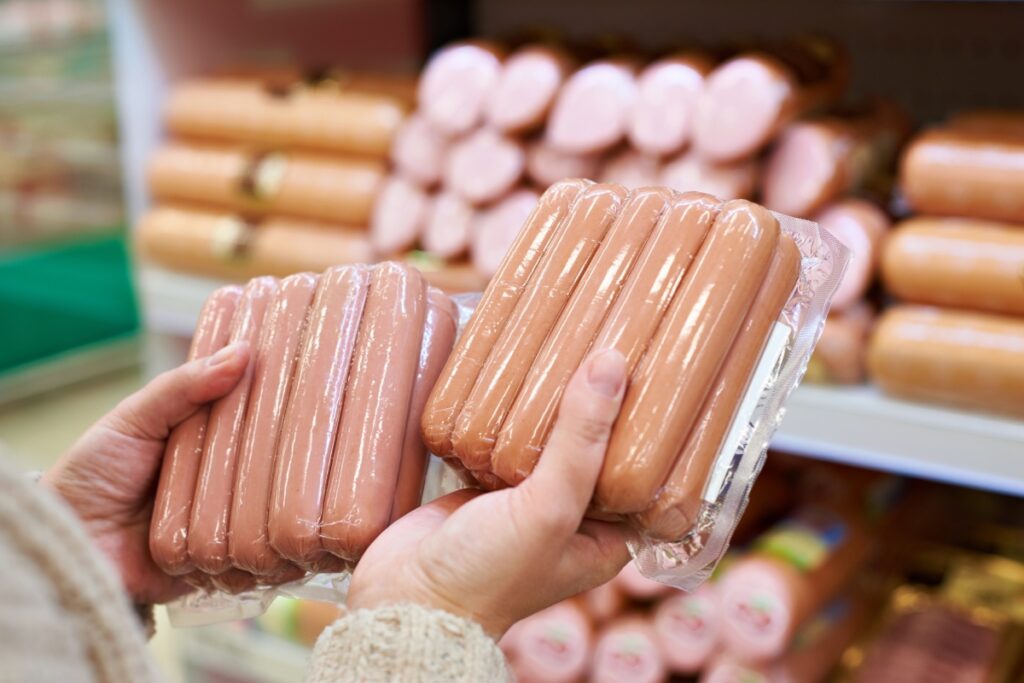When it comes to indulging in our favorite comfort foods, hot dogs often find their way to the top of the list. But have you ever wondered, “Can you eat hot dogs raw?” It’s a question that might have crossed your mind, especially if you’re a fan of hot dogs.
If the packaging says hot dogs are pre-cooked, you can technically eat them raw, but it’s not the best idea. It’s safer to cook them because it’s recommended by food experts and the FDA. Also, if the package doesn’t mention they’re precooked, never eat them raw. Always store hot dogs in the fridge and cook them before eating to be safe.
So, if you’re curious about this culinary curiosity, read on to satisfy your appetite for knowledge and maybe even some tasty hot dogs.
Why You Shouldn’t Eat Hot Dogs Without Reheating?
Food Safety: Hot dogs are a type of processed meat product, and they can potentially harbor harmful bacteria like Listeria, Salmonella, and E. coli.The pathogenic bacterium that causes listeriosis is Listeria monocytogenes. These bacteria can multiply if they are not stored and handled properly. Reheating them to an appropriate temperature (at least 165°F or 74°C) can kill these pathogens and make the food safer to eat.
Taste and Texture: While some people may enjoy the taste and texture of cold, reheating them can enhance the flavor and improve their overall quality. Heating them can bring out their natural juices, making them more flavorful and enjoyable.
Digestibility: Cold hot dogs can be harder to digest for some individuals. Warmess can help break down proteins and make them easier on the digestive system.
Tradition: In many cultures, They are traditionally served hot, often grilled or boiled. Eating them cold may not align with cultural norms and preferences.
Personal Preference: Ultimately, whether or not you should eat hot dogs without reheating them depends on your personal preference. Some people may enjoy the convenience of eating them cold, while others prefer the taste and safety of heating them.
Why Unheated Hot Dogs Are Unsafe to Eat?

Refrigeration Temperature: Listeria monocytogenes can grow slowly at refrigerator temperatures, which makes cold, unheated hot dogs an ideal breeding ground for this pathogen. Refrigeration does not necessarily prevent its growth; instead, it merely slows it down.
Listeria Risk in Processed Meats: The USDA acknowledges that, luncheon meats, cold cuts, fermented or dry sausage, and other deli-style meats can all be breeding grounds for Listeria. This bacterium can also be found in soft cheeses and unpasteurized milk.
Lethality of Listeriosis: Listeriosis, the illness caused by Listeria monocytogenes, is a serious condition that shouldn’t be underestimated. The Centers for Disease Control and Prevention (CDC) estimate that approximately 1,600 people contract listeriosis each year, and about 16.25% of those infected, or around 260 people, tragically lose their lives.
Salmonella : It is a bacteria notorious for wreaking havoc with symptoms that encompass fever, diarrhea, and painful abdominal cramps. This insidious microbe finds its home in both human and animal intestinal tracts. Beyond that, it insidiously lurks in diverse places, including milk, soil, and leafy vegetables.
E. coli : on the other hand, presents its own brand of menace. Particular strains of this bacterium can induce severe food poisoning, unleashing a trio of discomfort: diarrhea, abdominal pain, and the unwelcome company of vomiting. What’s most alarming is its modus operandi — contaminating food through the uninvited presence of fecal matter.
Listeria: a bacterium known as Listeria monocytogenes, prefers ready-to-eat foods as its battleground, with hot dogs being a notable contender. Its attacks manifest as fever, muscle aches, and a host of gastrointestinal issues. Vulnerable populations, including pregnant women, newborns, the elderly, and those with compromised immune systems, face the gravest risks when grappling with the nefarious Listeria.
Who Should Avoid Raw Hot Dogs?
- Newborns
- Compromised Immune Systems
- Pregnant Women
- Elderly Individuals
- Those on Specific Medications
- Individuals with AIDS
Ensuring Hot Dog Safety: Handling and Storage Guidelines
Handling Precautions for Hot Dogs:
Prioritize Hygiene: The paramount rule when dealing with hot dogs is maintaining impeccable cleanliness. Ensure that all food preparation surfaces, equipment, and utensils are scrupulously washed and sanitized between uses. This crucial step serves as a safeguard against the cross-contamination of bacteria from either raw or contaminated foods.
Cooking Vigilance: To guarantee safety, it must undergo thorough cooking until they reach an internal temperature of 165°F (74°C). This step becomes especially critical for individuals with heightened susceptibility to foodborne illnesses, such as pregnant women, young children, seniors, and those with compromised immune systems.
Cross-Contamination Prevention: It should never mingle with raw meats, poultry, fish, or seafood. Employ separate cutting boards, utensils, and plates for raw and ready-to-eat foods to staunchly prevent any cross-contamination.
Reheating Protocols: When reheating leftover hot dogs, take them to the steaming-hot zone to obliterate any lurking bacteria. This is of particular importance if they have spent time in the refrigerator before their encore in the microwave or on the stove.
Proper Hot Dog Storage:
Refrigeration Regimen: Hot dogs, when not on the menu, need a cozy spot in the refrigerator at a temperature of 40°F (4°C) or lower. Any room temperature loitering exceeding 2 hours (or 1 hour in temperatures over 90°F) can trigger a bacterial multiplication bonanza, escalating the risk of foodborne ailments.
Deciphering Package Dates: While product dating may be optional, some may manufacturers provide dates on the packaging. Adhering to the manufacturer’s recommendations for peak freshness and quality is a prudent practice.
Freezing Safeguard: If you’re grappling with an excess of them that won’t be devoured within a week, contemplate their icy fate. Also, they endure the deep freeze safely for 1 to 2 months, preserving their essence when stored properly in a freezer at 0°F (-18°C) or lower.
Airtight Assurance: Secure them in airtight or tightly sealed packaging to not only protect them from unwelcome contamination but also to uphold their freshness.
Exploring Alternatives to Consuming Raw Hot Dogs
Lean Poultry Varieties: Consider embracing the leaner side of hot dogs with options like chicken or turkey dogs. These choices offer a healthier, lower-fat alternative for your culinary desires.
Lean, Cooked Meats: Seek solace in boneless and skinless chicken breasts, ground turkey, or lean ground beef. These protein alternatives are notably lighter on the stomach, providing a less fatty and equally satisfying experience.
Savory Chicken Sausages: If you opt for a meaty indulgence, opt for chicken sausages that boast natural ingredients and avoid detrimental additives such as onion and garlic. These sausages deliver a delectable alternative to traditional hot dogs.
Nutrient-Rich Substitutes: Dabble in the world of nutrient-rich alternatives. Peanut butter and an assortment of fruits and vegetables can tantalize your taste buds without the need for hot dogs. These options infuse both flavor and nutrition into your culinary repertoire.
Exploring Delicious Variations in Hot Dog Recipes

For those who savor the art of cooking hot dogs, a world of delectable possibilities beckons. Here are a few crowd-pleasing favorites:
Grilled Hot Dogs: Elevate the classic by grilling them to a mouthwatering char, then nestle them within soft buns adorned with your choice of toppings.
Chili Dogs: Embark on a flavor adventure by crowning your grilled hot dogs with hearty beef or vegetarian chili, cheese, onions, and any other preferred accouterments.
Slaw Dogs: Experience a fusion of textures and tastes by introducing coleslaw them, imparting a satisfying crunch and a tangy twist.
Loaded Hot Dogs: Unleash your culinary creativity with a smorgasbord of toppings. Consider sautéed onions and peppers, savory bacon, spicy jalapeños, or even indulgent macaroni and cheese for a unique hot dog masterpiece.
FAQs
Q: Can I eat hot dogs without cooking them?
A: Eating raw hot dogs without cooking them is generally not recommended. Raw hot dogs may contain harmful bacteria such as Salmonella or E. coli, which can lead to foodborne illnesses if consumed raw.
Q: Why can’t I eat raw hot dogs?
A: Raw hot dogs can pose health risks due to the potential presence of bacteria in the meat. These bacteria can cause food poisoning and lead to symptoms like vomiting, diarrhea, abdominal pain, and fever. Cooking hot dogs thoroughly helps to eliminate any harmful bacteria, making them safer to eat.
Q: How should I cook hot dogs to make them safe to eat?
A: To ensure that hot dogs are safe to eat, they should be cooked to an internal temperature of 160°F (71°C). You can grill, boil, or even heat them in the microwave. It is essential to cook hot dogs until they are steaming hot throughout to kill any bacteria that may be present.
Q: Can I eat hot dogs that are slightly pink in the middle?
A: No, eating hot dogs that are still slightly pink in the middle is not safe. Hot dogs, like any other meat product, should be fully cooked to an internal temperature of 160°F (71°C) to ensure the elimination of harmful bacteria. Consuming undercooked hot dogs may increase your risk of foodborne illness.
Q: Are there any alternatives to eating raw hot dogs?
A: Of course! If you want to enjoy a delicious hot dog without the need for cooking, there are a few alternatives you can consider. Opt for pre-cooked or smoked hot dog sausages available in the market. These can be safely consumed without further cooking, as they have already undergone heat treatment to kill harmful bacteria.
Q: Are there any health risks associated with eating undercooked hot dogs?
A: Yes, consuming undercooked or raw hot dogs can pose significant health risks. As mentioned earlier, hot dogs may harbor bacteria like Salmonella or E. coli, which can cause food poisoning. These infections can lead to dehydration, kidney failure, or even death in severe cases. Handling and cooking hot dogs properly is crucial to minimize these risks.
Q: Can I freeze raw hot dogs to make them safer to consume?
A: Freezing raw hot dogs won’t make them safe to consume without cooking. Freezing may help preserve the quality of the hot dogs but will not kill any bacteria in the meat. Remember, cooking hot dogs thoroughly before eating them is essential to ensure food safety.
Final Words
While some hot dogs may be labeled as pre-cooked, it’s a safer practice to cook them thoroughly before consumption. This recommendation not only aligns with expert advice but also adheres to guidelines set forth by the FDA.
Further, it’s essential to exercise caution, especially when the packaging doesn’t specify whether they’re pre-cooked. To ensure your safety, always store them in the refrigerator and follow cooking guidelines to fully enjoy this classic treat.



